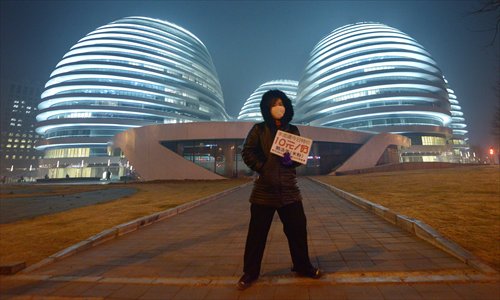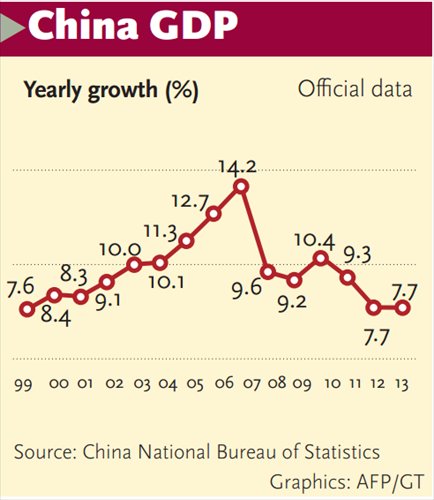GDP growth remains 7.7%

A restaurant greeter holds a billboard advertising a noodle meal priced at 10 yuan near the entrance of an office building in Beijing on Wednesday. China's economy grew 7.7 percent last year, the government said on Monday, in line with expectations. Photo: AFP
Daily Special: China meets 7.5 percent growth target
China's economy grew 7.7 percent in 2013, a 14-year low but which is considered steady growth while the government continues to push forward economic restructuring.
In the fourth quarter, the country's overall economic growth was 7.7 percent year-on-year, slower than the previous quarter's 7.8 percent. This left the growth for the whole of 2013 unchanged from the revised rate of 7.7 percent in 2012, but higher than the official target of 7.5 percent.
"This is not an easy task," Ma Jiantang, head of the National Bureau of Statistics (NBS), said at a press conference in Beijing on Monday. "Faced with increasingly complicated external and internal conditions, the overall national economy still showed stable and moderate growth in 2013 thanks to the new leadership's commitment to reform."
Besides the higher comparison base over the same time in 2012, economic growth in the final three months of 2013 was mainly dragged by sluggish fixed-assets investment amid strict control over fast-growing local government debt, said Tang Jianwei, a macroeconomic analyst with the Bank of Communications in Shanghai.
Figures from the NBS indicate that fixed-assets investment growth fell to 19.6 percent year-on-year in 2013 from 20.2 percent in the first three quarters of 2013.
Ma said that investment will see steady progress in 2014 due to rural urbanization and inadequate supply in sectors including environmental protection, railways and subways.
Echoing Ma, Li Daxiao, director of research at Yingda Securities, predicted that China will see a controllable drop in fixed-assets investment to 19.3 percent in 2014, as many companies in China will continue to be confronted with severe overcapacity.
Manufacturing overcapacity has long been regarded as a drag on the economy, but the situation is improving as the central government is stepping up efforts to encourage cost-effective and energy saving production lines, as well as optimizing industrial structure.
According to the NBS, last year's GDP was 56.9 trillion yuan ($9.4 trillion), about 46 percent of which was contributed by the value added by tertiary industry, surpassing the share held by the secondary industry for the first time.

While investment was still the No.1 driving force of GDP, which contributed to 54.4 percent of GDP growth in 2013, domestic consumption seized a 50 percent share.
Li predicted that the share of consumption will closely follow or even surpass that of investment in 2014, as authorities prefer the former to drive the economy.
Ma noted that net exports of goods and services accounted for -4.4 percent of GDP, reflecting weak demand amid the global economic downturn but he believes that the situation will be improved this year.
According to a report by the World Bank issued on January 14, this year the global economy will increase to 3.2 percent from last year's 2.4 percent, hitting 3.4 percent in 2015.
This year's economy will "surely" be stimulated by the central government's deepening reform and the global economic recovery, said Ma, adding that the official target for GDP in 2014 is set to be released on March 5.
"Even though [year-on-year] GDP growth may not reach 8 percent as we expected, the chance for it to rise to around 7.8 to 7.9 percent is quite high" in the first and second quarter of this year, Lu Ting, an economist with Bank of America Merrill Lynch in Hong Kong, told the Global Times.
Li thought the target will remain fixed at 7.5 percent, as the government expects steady, not fast, economic growth to be a solid foundation for structural readjustment.
The NBS also revealed that the per capita disposable income of urban households was 26,955 yuan ($4,453), up 7 percent from a year earlier after deducting price factors while China saw a faster growth of 9.3 percent in per capita net rural income, mainly due to the government's financial support for agriculture and rising wages paid for migrant workers. The consumer price index in 2013 rose 2.6 percent year-on-year.